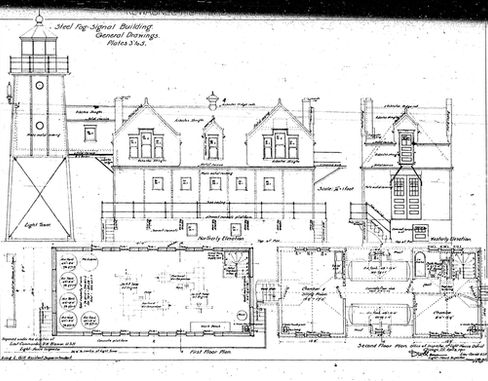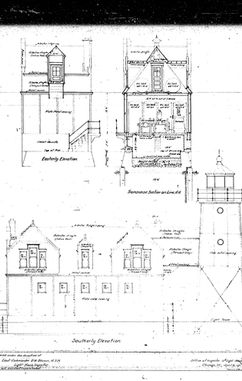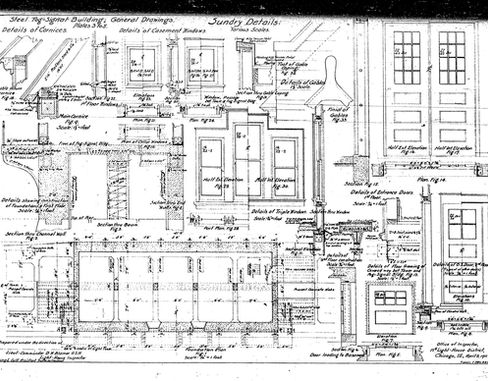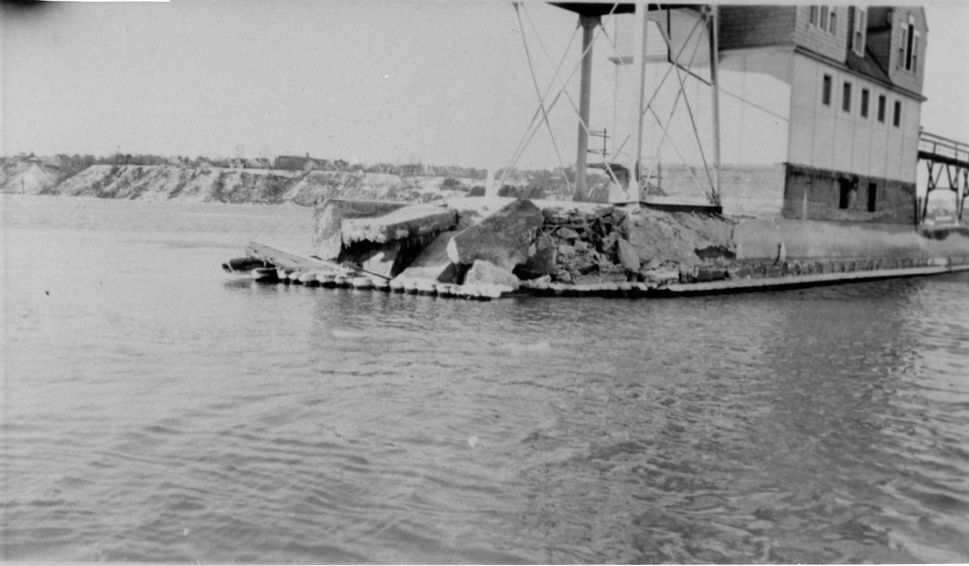KEWAUNEE
Light Station
A Detailed History
A New Lake Michigan Harbor
(1836 - 1888)
In 1836, rumors of gold in a muddy river east of Fort Howard – modern day Green Bay – spurred the creation of what would become the City of Kewaunee, Wisconsin by European settlers. Before this time, only small groups of Native Americans inhabited the land, enjoying an abundance of salmon that spawned upriver every year.
Initially, the river mouth was filled with sand and mud, not allowing ships in or out of the harbor.
As the little settlement began to grow, the river was dredged, the mouth rerouted from present-day Fr. Marquette Park to its current location, and a large, protected harbor created. At the same time, in 1880/1881 two 500' long piers were built from the river's new mouth. These were not the first piers built here, but these were the first piers to be built by the US Government - recognizing the potential importance of the new port town.
The Railroad Comes to Town &
A Lighthouse is Built
(1889 - 1912)
At the end of the 1880s a rail line was started in Green Bay, heading east towards Luxemburg. Knowing the line would eventually end at Kewaunee which would mean an increase in ships to the port, a small wood-framed light was exhibited on the end of the North pier beginning in 1889. (Photo) In 1891, the railroad link was completed to Kewaunee and ship traffic exploded as a result.
To get cargo from rail to water, however, the rail cars were unloaded and the cargo re-loaded onto the ship, only to be re-loaded into train cars at its destination. This slow, laborious process was known as "break bulk shipping."
The following year in 1892, the wooden-hulled ANN ARBOR #1 began cross-lake rail ferry service between Kewaunee and Frankfort, Michigan. Sending entire train cars across Lake Michigan by boat ended break bulk shipping here, and allowed the railroads to bypass busy Chicago, saving time and money.
The new “carferries” continued to sail to Kewaunee as well as Manitowoc and Milwaukee on the Wisconsin shore, and Menominee, Michigan to the Northwest of Green Bay. On the Michigan shore, ferries docked at Frankfort and Ludington. Carferries docked at Manistique, Michigan for a time as well. As the years passed, dozens more ships were built for railroads to transport their trains across the lake.

Kewaunee Lighthouse #1 on the North Pier. Seen here either 1889 or 1890. Photo KCHS
In 1891, the North pier was also lengthened 300’ with the lighthouse being moved 200’ closer to the lake. At the end of the extended pier, a pole with a small lantern was placed to create a front range light to precisely guide ships into the harbor.
Both lights burned fixed red, with the front light showing 23 ½ feet above the lake, and the rear light located approximately 100 feet behind at a height of 42 ½ feet. Sailors would line the lights up so the rear light appeared on top of the front. The red color was accomplished by using a red, glass chimney over the lamp, rather than the normally clear glass.
In November 1893, a conduit or track system was installed to allow the keeper to service the front range light’s lens-lamp, with the lens-lamp mounted on a small car atop the conduit. The car ran on a loop of conduit track that carried the lens-lamp to the keeper in the 1889 light tower, then back out to the post without him having to leave the rear tower. This system was in use less than a year until August of 1894, when the post lamp was discontinued and the 1889 frame tower moved another 300’ closer to the end of the recently-lengthened pier.
Once the frame tower was securely bolted to its new spot on the pier, construction began on a steam fog signal house. This rectangular building was built immediately behind the light tower and was used to generate steam to power the 10” diameter Crosby automatic fog whistle, sounding for the first time January 31, 1895. The whistle was mounted above the lakeward end of the fog signal building, set inside a parabolic reflector to direct the sound lakeward. During construction of the fog signal building, 275 feet of elevated walkway were built to allow the keepers safe passage along the pier to and from the lighthouse in all types of weather.
In October 1895, conduit was reinstalled and a front range light again added to the station 200’ in front of the main tower. In 1897 the conduit was lengthened an additional 200’.
Both of these changes are presumably due to the pier being lengthened again.
In 1905, the front range light and associated conduit to service the lamp were removed. The main (1889) tower was moved to the outer end of the pier, connected to the fog signal building with an elevated walkway that had previously been used in Sheboygan. The 1889 main lighthouse tower was then to be used as the front range light. 400’ towards shore, a 60-foot-tall metal skeleton tower was built to serve as the new rear range light. The tower was equipped with a lens lamp that was hoisted in and out of the lantern room from the pier via rope and pulley.
By this time both the North and South piers were the same length, extending into Lake Michigan nearly 1/4 mile.

The configuration of the north pier from 1905 until the new lighthouse on the south pier was built in 1912. Here we see the steel fog signal building, with the whistle's sound deflector above, then the 65' rear range tower, then the 1889 lighthouse as the front range light.
In 1908, a brick duplex was built on the bluff on the south side of town to house the station’s keepers. First requested by the Lighthouse Board in 1895, funds weren't approved by Congress until 1902. Issues selecting a suitable site, then obtaining the deed for the site caused further delays.
As the light station was still located on the north pier when the house was completed, the keepers would have to row across the narrow harbor to the lifesaving station in order to tend the light or fog whistle on the North pier.
Prior to the construction of the duplex, keepers were required to rent a spare room in town.

The Kewaunee Lightkeepers' Quarters was located at 718 Main St above Selner Park.
This photo was taken in 1914.
This house was demolished in the early 1990s and a new, private house built in its place.
The South Pier and New Lighthouse
(1912 - 1931)
Beginning in 1910, the wooden pilings of the 1881 South pier were cut off at water level and a new pier was laid atop the pilings, made of reinforced concrete. The lighthouse complex on the North pier had undergone so many changes since 1889 that it was decided to build an entirely new lighthouse on the new South pier, outfitted with all the "modern technology."
The new fog signal building had a concrete foundation, brick main level framed and sheathed on the exterior by steel, and a wood-framed second floor. A 45’ tall, open-frame light tower was built immediately in front of the fog signal building, connected to the 2nd level by a short passageway. An elevated walkway beginning near the base of the pier led to a door on the 2nd floor of the fog signal building, allowing keepers to walk out of the grasp of the waves that often broke on the pier below.
In the early 1900s, steam was falling out of favor with the Lighthouse Service due to the challenges in creating and storing it. Because of this, it was decided the fog whistle in the new lighthouse would be powered by compressed air.
According to the building plans, 45 HP kerosene-powered "Rumley oil-pull" engines drove Chicago Pneumatic air compressors (two of each for redundancy) to compress air for the 10” diameter Crosby chime air whistle. The air was stored in five massive tanks on the first level (each 4 feet diameter by 8 feet tall) plus two more tanks laid horizontally on the 2nd level. The skeleton tower (rear range light) was moved onto the South pier deck (see photo at below left) to maintain the same range that had been used on the North pier.
A 5th Order Fresnel lens was placed in the new tower, lit by oil lamp. The new lighthouse was first exhibited the night of March 26, 1912 - but for some unknown reason, both it and the rear range light maintained their red, fixed characteristic.
The new fog whistle was not placed into service on South pier until the end of June.
The fog signal building on the North Pier, the 1889 tower and the catwalk were demolished and a simple, flashing red light was established at the end of the north pier in 1913.
In 1915 the flashing red light on the old north pier became the front range light. The 60’ skeleton tower was moved from the south pier deck to the base of the south pier still serving as the rear range light. The light in the 1912 lighthouse on the South pier was changed from fixed red to fixed white, and was renamed the “Kewaunee Pierhead Lighthouse.” (See 1929 Chart Below)
Using the North light as the front range light shifted the range line to better avoid a newly discovered shoal about two miles from the end of the south pier. In 1935, a sheet steel piling crib was built atop this shoal and an acetylene light with electric fog siren built to mark it. The crib still marks the shoal today, lit by a modern D9 tower.

A navigational chart of Kewaunee from 1929.
Notice the range line used to avoid the shoal located directly off the S. pier.
The rear range tower is at the base of the S. pier, and the small marker on the N. pier is the front range light.
In 1919, electricity was run along the pier to the lighthouse, the oil engines were replaced with an electric motor to drive the compressor, and the chime whistle replaced with a Type F Diaphone fog horn. Diaphones require less air at a lower pressure to sound, compared to whistles, requiring less of those massive air tanks. The sound of the diaphone makes it very unique, and instantly identifiable as a fog signal.
The unique sound characteristic of the diaphone consists of a powerful sound blast, ending in a “grunt” at the end of the horn blast as the air supply is cut and the sound-generating piston slows down inside while air si.
The electric motor was given a gasoline backup for the air compressor, with a gasoline generator to provide building and beacon power if shore power failed. The oil lamp inside the lens was removed and the light was lit by electricity from this point on. (According to the 1920 Annual Report of the Commissioner of Lighthouses)
In November of 1930, the railroad carferry ANN ARBOR #3 collided with the end of the south pier, badly damaging the pier and twisting one of the tower's support legs. During the winter, the light tower was moved onto a barge, then stored at the base of the pier.
The damaged concrete and timber at the end of the pier was repaired, and a square tower built out of the lakeward gable of the fog signal building. When the work was completed, the lighthouse was left looking as it does today.
The former tower was stored at the base of the south pier for about a year until May 27, 1932 when it was sailed to Milwaukee aboard the barge Riprap, towed by the Lighthouse Tender Hyacinth. Slight damage to the former tower was repaired at the Milwaukee Lighthouse Depot, and the tower was installed in Chicago in 1938 as the “Chicago Harbor Southeast Guidewall Lighthouse.” (External Link) This tower still serves as an active Aid to Navigation, marking the entrance to the Chicago River Lock.
The Glory Years
(1931 - 1981)
The lighthouse would remain vastly unchanged from 1931 until its automation in 1981. The period from 1931 until the US Lighthouse Service merged with the Coast Guard in 1939 is the era we are focusing our restoration on – also known as the “period of interpretation.”
Between 1935 and 1937, the north pier was removed and the current 3,100’ breakwater enclosing the North end of the harbor was built.
Today, a small riprap jetty sits on the north side of the river’s mouth. Some pilings of the original North pier are visible mostly submerged about 200 feet north of the current jetty.
At some point (exact year yet TBD) the Type F Diaphone was replaced with two Type F2T Diaphones. Two horns were installed to ensure constant operation in case one horn was being repaired.
Though the F2T is known for its 2-tone “BEEEEE-OHHH” sound, its wide use in the US can be attributed to its versatility. In addition to sounding in two-tone, it can be easily adjusted to sound as a single tone with a grunt, same as the classic "Type F."
Kewaunee's horn would continue to be sounded in this way – single tone with a grunt, never sounding a 2-toned signal.
Listen to the audio clips above to hear for yourself! Both clips are made from the exact same horn that was used here in Kewaunee when it was being re-used in Duluth, MN. By making an adjustment to a small valve at the base of the horn's "throat," the tones can be changed from the "classic" Type F sound with the heavy grunt to the 2-tone "Beee-Ohhhhh" sound.
The lighthouse would also be equipped with a marine radio direction finding transmitter. Using a directional antenna mounted on the roof of a ship’s pilothouse, the crew would listen for radio signals transmitted at specified intervals on a specified frequency. Kewaunee’s unique identifier was the Morse code letter “G.” ( – – ● )
By plotting the direction that the signal is coming from on their chart, and then repeating the process using a different transmitting station, the ship’s crew were able to accurately triangulate their position. The radio beacon at Kewaunee was also synchronized with the fog horn beginning in June of 1931, allowing ship crews to determine their distance from the lighthouse by timing the delay between the radio signal and the sound of the horn reaching them. Dividing the delay in seconds by 5 gives the approximate distance in miles.
Today, we do the same thing by timing the delay between lightning and the thunder that follows.
The Kewaunee harbor buzzed with activity throughout much of the 20th century. Sawmills, commercial fishing enterprises, a shipbuilder, and of course the carferries ensured a steady stream of goods and people through the Kewaunee piers.
Continued Below
Kewaunee's
Connection to North Korea -
since 1968
The Kewaunee Shipbuilding Corporation was established in 1941 and built 80 vessels for the US Military during WWII.
One of these Kewaunee built ships, USS PUEBLO (Launched 4/16/44 as FS-344) and her crew were captured in the Sea of Japan by North Korean forces in January of 1968.
The ship was on a spy mission for the US Government, under the cover of oceanographic research. During the siege, one crewmember aboard PUEBLO was killed. The remaining 82 crew members were imprisoned and tortured in North Korea, finally being released on December 23, 1968 after 11 months in captivity.
USS PUEBLO is currently a propaganda museum ship in Pyongyang, North Korea and is the only commissioned US Naval vessel being held captive by a hostile foreign power.


USCG Keeper Terry Lychwick was stuck at the lighthouse for 20 hours during a November 1970 storm.
He visited the City’s Lighthouse Preservation Committee in 2021 and told of a fierce storm with high waves coming into the harbor and driving wind making even the catwalk dangerous.
A search through the logbook for that month shows the storm occurring the night of November 2, 1970.
When Lychwick came on watch at noon on the 2nd, the winds were NE 5-8kts.
At 8pm, the winds had increased to 25-30 kts.
By midnight, when his watch was supposed to be over, the winds were howling at 40-50 kts with waves estimated at 12 feet.
When Lychwick was finally relieved at 8am on the morning of the third, the winds had shifted and diminished to 10-15 kts out of the South.
Automation and Mothballing
(1981 - 2011)
Many lighthouses maintained the need for keepers due to their remote locations and the difficulty to get reliable electricity to those locations. This left them burning lard, then kerosene in their lamps well into the 20th century. Later, diesel generators provided power for these off-shore and remote locations. The Kewaunee Pierhead Lighthouse didn’t have that problem, having been electrified very early in the 1900s. Keepers were still needed, however to sound the fog horn and monitor the Radio Direction Finding transmitter, or to operate backup generators if power failed. Technology did eventually catch up, and the need for keepers at the Kewaunee Lighthouse was eliminated
In 1981, the diaphones were removed, the interior gutted of all equipment, and the lighthouse was shuttered. The Fresnel lens remained in the tower, still being lit by a 500-watt bulb. A photocell attached to the light turned it on and off automatically every day. A simple air horn attached to a fog detector replaced the thundering diaphones. In the 90s, the horn was replaced with an electronic fog horn that uses a spinning electromagnet to generate a tone. The fog detector has been replaced with a Coast Guard “Mariner Radio Activated Sound Signal” or MRASS. MRASS allows fog signals to be normally silent and sounded on-demand by mariners using VHF radios.
The air supply tanks at the base of the tower and the fuel oil tanks at pier level were the only obsolete materials left behind – simply because they’re too large to remove. Shortly after automation, the elevated catwalk was also removed, leaving a door to nothing on the 2nd floor of the lighthouse.

View from a passing carferry shortly after automation (Early 1980s) Photo EPA
On November 26, 1990, the SS Badger sailed past the Kewaunee Pierhead lighthouse for the final time, ending Kewaunee’s rail ferry service after almost 100 years.
Moving train cars by ship was simply no longer more economical than pulling the trains through Chicago. The SS Badger would sail again beginning in 1991 carrying vehicles instead of rail cars, but Manitowoc was (and still is) the chosen Wisconsin port for the Lake Michigan Carferry.
Since Badger's last trip to Kewaunee, the harbor has seen little commercial traffic. Despite this, the Kewaunee Pierhead Lighthouse has maintained its status as an icon of the community.
A New Lease on Life
(2011 - Present)
Pursuant to the National Historic Lighthouse Preservation Act (NHLPA), the City of Kewaunee applied for and was granted ownership of the Kewaunee Pierhead Lighthouse. The lighthouse officially passed from the National Park Service to the city in September 2011.
In 2022, the lighthouse and pier were added to the National and State Registers of Historic Places - reinforcing the important role the lighthouse played in the development of commerce in the area.
Since the acquisition, the city’s Lighthouse Preservation Committee has partnered with our non-profit group “Friends of the Kewaunee Pierhead Lighthouse.”
Through further assistance and partnership with the Kewaunee County Historical Society, other area organizations, and through the help of grant funding and substantial private donations, restoration has begun!
History compiled by Jake Heffernan using information from:
External Links where applicable)
Kewaunee County Historical Society, Kraig Anderson (Lighthouse Friends), Terry Pepper (Seeing the Light), Kurt Fosburg (Superior Lighthouse Restoration), Harry Barry, Jeff Laser (reTurn Our Old Tone aka TOOT & Detour Reef Preservation Society ), US Coast Guard, Various Logbooks from the Kewaunee Pierhead Lighthouse, Various reports by the United States Lighthouse Board, Blueprints of the Kewaunee Pierhead Lighthouse and associated structures, United States Lighthouse Society, Various manufacturer drawings of Type F and Type F2T Diaphones, physical inspection of various diaphones

















